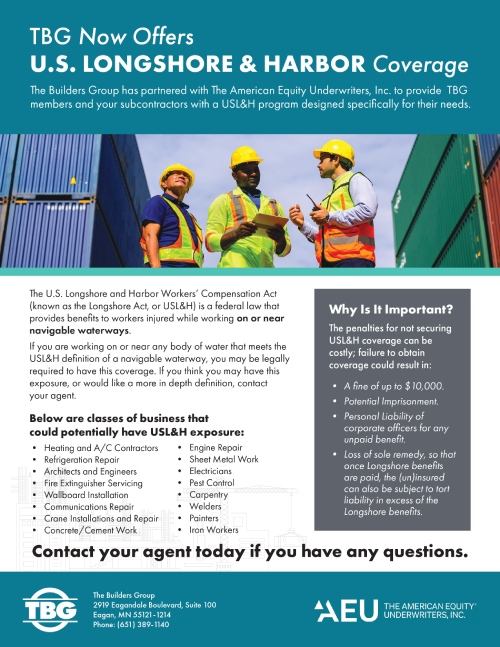
TBG Now Offers U.S. LONGSHORE & HARBOR Coverage
Navigating the maritime legal landscape can be as tricky as steering through choppy waters. The U.S. Longshore and Harbor Workers’ Compensation Act (USL&H), commonly referred to as the Longshore Act, is a law that construction-related Employers can often overlook.
This federal law provides compensation to workers injured on or near navigable waters. If you own a business (or act as an insurance agent for businesses) that operates in
proximity to such waterways, this coverage isn’t just recommended; it may be a legal requirement.
While many might assume that the Longshore Act only applies to businesses directly involved in shipping or water transportation, that’s a misconception. The reality is that many types of businesses have potential USL&H exposure (potential obligations under the Act).
Understanding the complexities of this federal law and the vulnerabilities it presents, TBG has teamed up with The American Equity Underwriters, Inc. This partnership aims to provide TBG members and subcontractors with a specialized USL&H program tailored to meet their needs.
Ignoring the Longshore Act can come at a hefty cost. Employers lacking this coverage could face penalties that include:
- •Fines of up to $10,000
- Potential imprisonment
- Personal liability for corporate officers for any unpaid benefits (there is no corporate veil)
- Additional tort liability in excess of the Longshore benefits
Steps for Gaining USL&H (Longshore) Coverage
- Understand your exposure and assess your risk. If your business falls into one of the categories mentioned or you need more clarification about the risk. In that case, it is
crucial to consult with your insurance agent to get an in-depth explanation of the Longshore Act and help determine whether you need this specialized coverage. - Secure coverage. TBG now offers U.S. Longshore & Harbor Coverage in partnership with The American Equity Underwriters, Inc. If you’re a TBG member or subcontractor, this is an invaluable resource tailored to meet the specialized requirements of maritime exposure.
